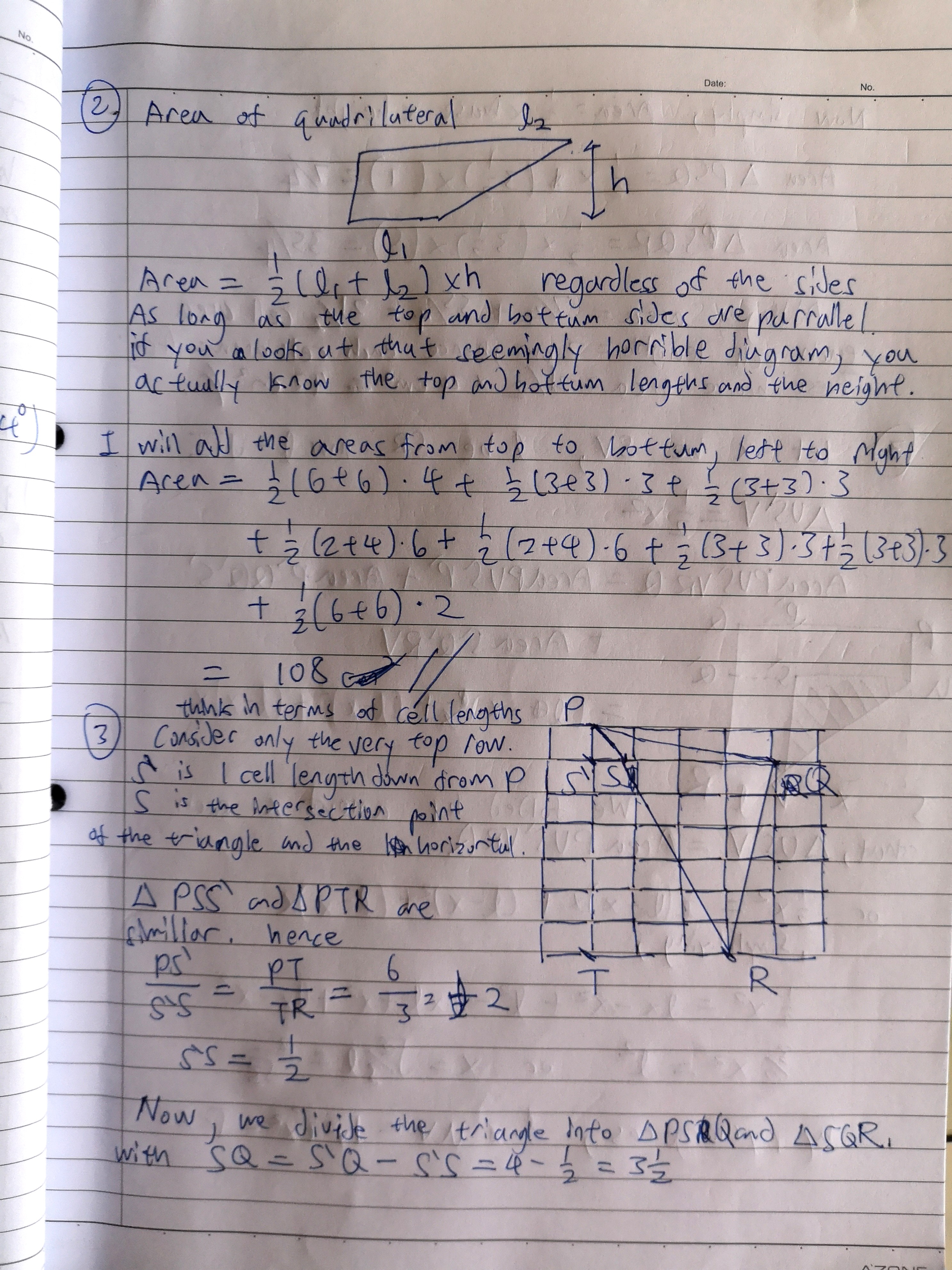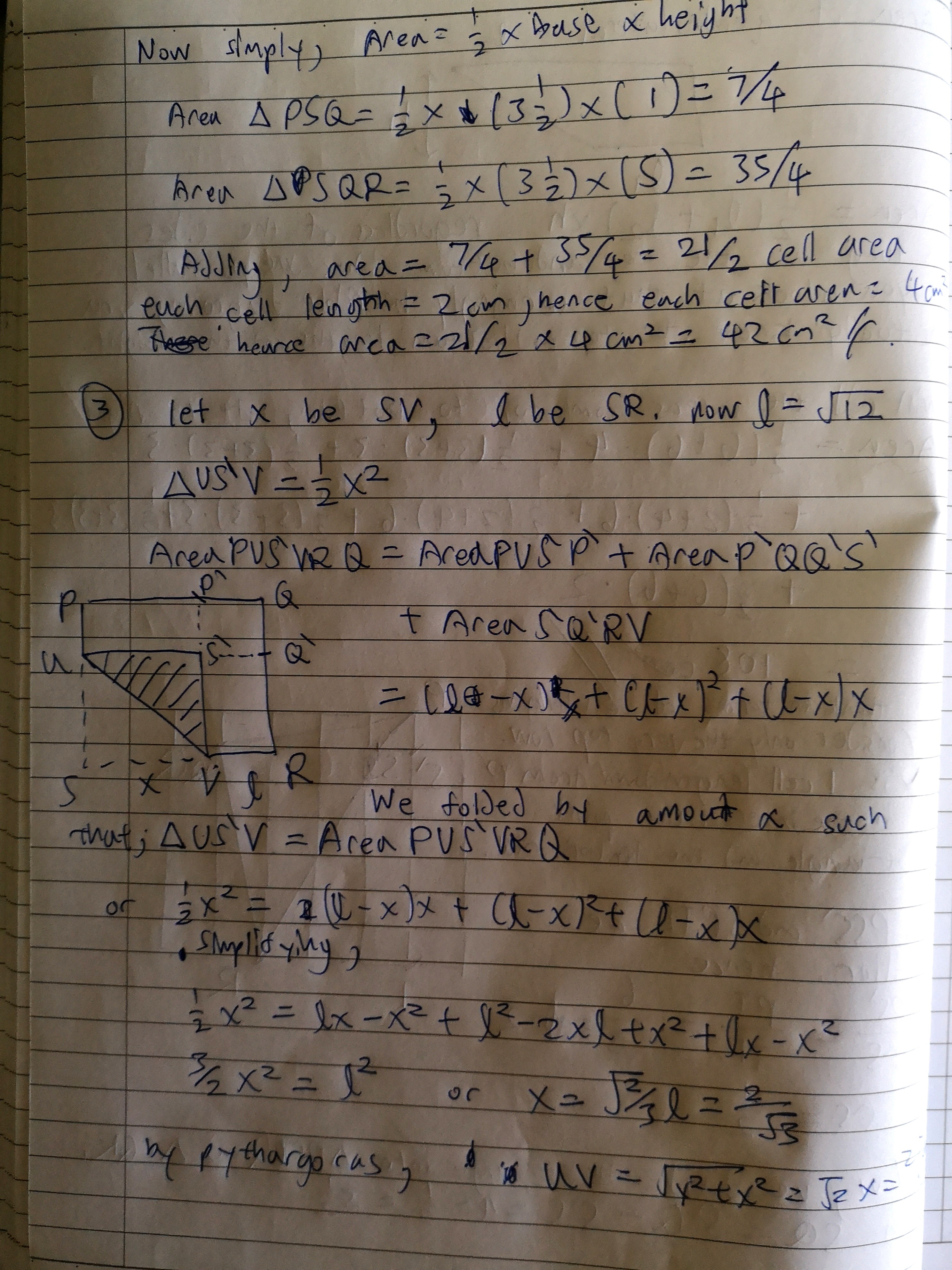Ask Singapore Homework?
Upload a photo of a Singapore homework and someone will email you the solution for free.

Question
Secondary 1 | Maths
2 Answers Below
Anyone can contribute an answer, even non-tutors.

I would be grateful if u could help me out with this. Thanks
= 3 x 3 x 4 + 6 x 6 + 6 x 2 + 6 x 4
= 108cm²
There are 4 small parallelograms of base 3cm x perpendicular height 3cm.
Area of parallelogram = base x perpendicular height
(Or area of two triangles inside it divided by a diagonal = ½ x base x height x 2 )
The left and right shaded areas 2 congruent trapeziums. When combined, they give a square of 6cm by 6cm.
The top and bottom shaded areas are also parallelograms with base of 6cm. One has perpendicular height 4cm the other has perpendicular height 6cm.
Rectangle area = 4 x 6 x 2cm x 2cm
= 96cm²
Subtract the areas of the 3 triangles bounding it.
½ x 6 x 3 + ½ x 4 x 1 + ½ x 5 x 1
= 9 + 2 + 2.5
= 13.5
13.5 x 2cm x 2cm = 54cm²
Triangle PQR area = 96cm² - 54cm² = 42cm²
US'V = white area PQRVS'U
Since US'V = USV, then all 3 areas are equal.
So area of each = 12 ÷ 3 = 4
Square US'VS = 4 x 2 = 8
Area of square = ½ x diagonal² = 8
Diagonal² = 16
Diagonal UV = √16 = 4
For the triangle PQR question
Edit :
PST = 35°
Draw the triangle and you will find that there are 2 isosceles triangles RQS and RQT.
From this, compare their sides.
RQ = RS and RQ = RT
This implies RS = RT . So RST is isosceles also. From here it is easy to find.
draw lines from A and B to the intersection the two curved paths. Call the intersection C.
AC = BC = AB
(all are radius of the quarter circles, which are identical and are equal to one side of a square, 6cm)
So triangle ABC is equilateral
We have divided the unshaded area into
1 equilateral triangle and 2 sectors.
The two sectors are identical and have angle of 30° (90°of the square corners - each corner of the equilateral triangle).
They can be combined to form 1 sector of angle 60°.
Area of shaded parts
= Area of square - area of triangle - area of combined sector
= 6 x 6 - ½ab sin c - 60°/360° x πr²
= 36 - ½(6)(6) sin60° - 1/6 π(6²)
= 36 - 18(√3 / 2) - 6π
= 36 - 6π - 9√3
a = 36, b = 6, c = 9
a + b + c
= 36 + 6 + 9
= 51
the solution for first question
Yes Pythagoras will also work to find the area of the triangle in the last question. Just that it's more steps.
I.e divide the △ into two right angled △, where each has a base of 3cm.
6² = 3² + h², where h is the height of each right angled △ (and also the height of the equilateral △)
Then h = √(6² - 3²) = √27 = √(9x3) = 3√3
Area of △= ½ x 6 x 3√3 = 9√3
But it's good that you understand how to do them now.
First one got me thinking a while as well. Was trying to see which shapes could be drawn . Tried trapezium but didn't work. But the thing is that the first question assumes that the quadrilateral is convex.
If it were a concave quadrilateral then it's different story already.
I used pythagoras theorem bcoz 5 is a Pythagorean triple and hoping I would somehow find its fit 12,13
Most welcome, if you got any more question you can notify me
See 2 Answers





